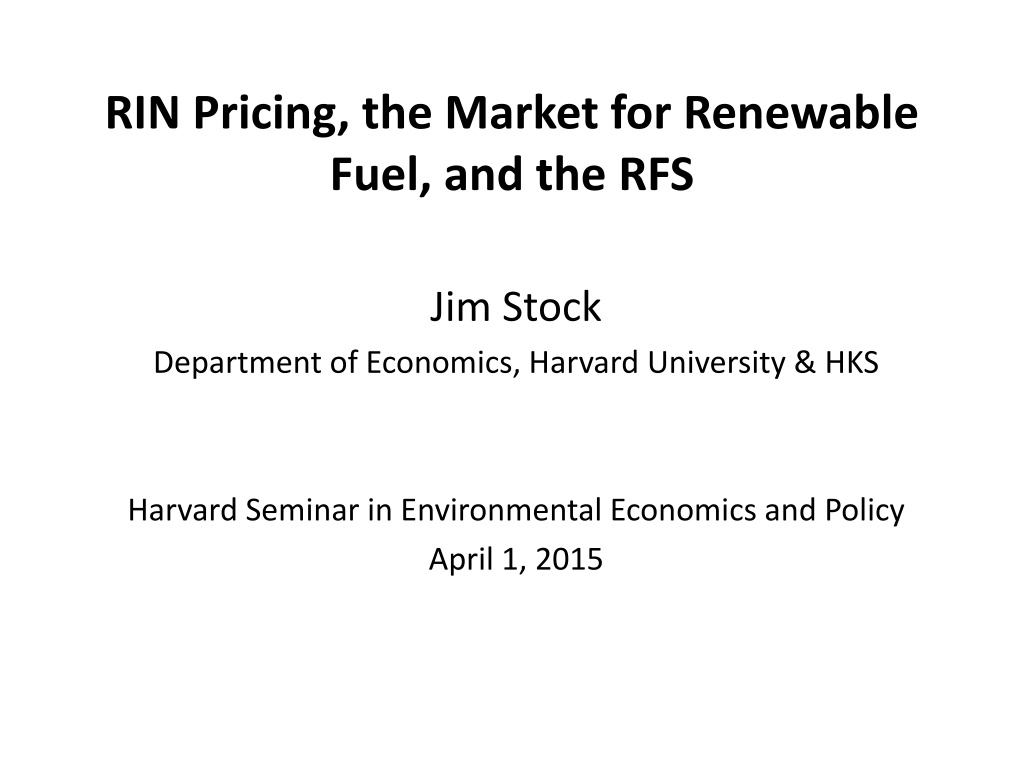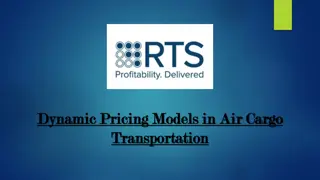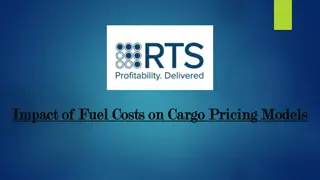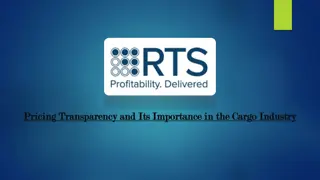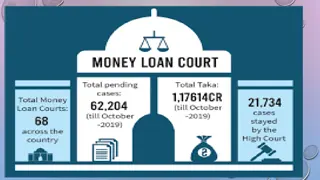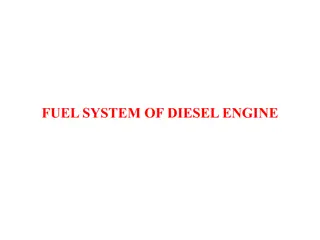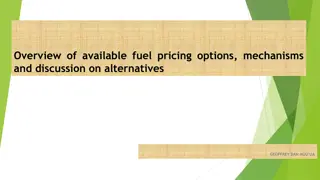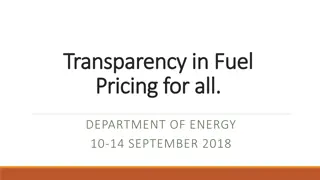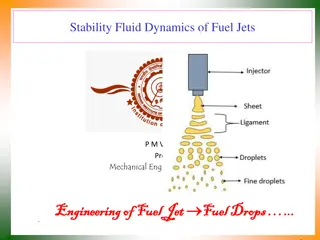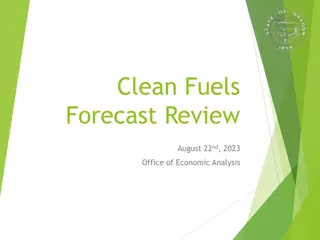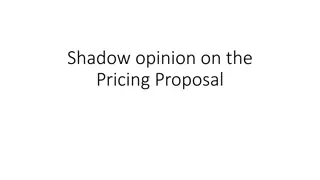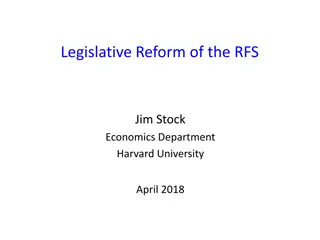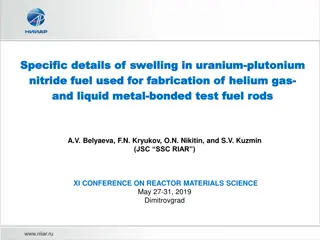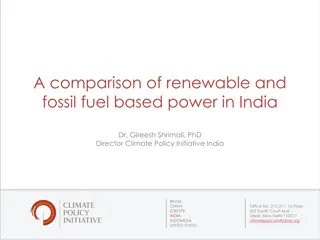RIN Pricing, Market Dynamics, and Policy Issues in Renewable Fuel Sector
The article discusses the Renewable Fuel Standard (RFS), Renewable Identification Numbers (RINs), RIN pricing fundamentals, pass-through effects, and policy implications in the renewable fuel market. It delves into legislative context, fuel categories, biofuels expansion, and a dynamic model of the RFS and US biofuels markets. The emphasis is on understanding the complex interplay between regulations, market forces, and policy goals in shaping the renewable energy landscape.
Download Presentation

Please find below an Image/Link to download the presentation.
The content on the website is provided AS IS for your information and personal use only. It may not be sold, licensed, or shared on other websites without obtaining consent from the author. Download presentation by click this link. If you encounter any issues during the download, it is possible that the publisher has removed the file from their server.
E N D
Presentation Transcript
RIN Pricing, the Market for Renewable Fuel, and the RFS Jim Stock Department of Economics, Harvard University & HKS Harvard Seminar in Environmental Economics and Policy April 1, 2015
Outline A. Background 1. The RFS: Legislative authority and nested fuel structure 2. Fuel categories and RINs 3. Biofuels expansion: Statutory goals, actuals, and waiver authorities B. RIN prices 1. The Blendwall 2. RIN price fundamentals 3. RIN price history 4. Pass-through of RIN prices to fuel prices C. A Dynamic Model of the RFS and US Biofuels Markets 1. Model structure 2. Simulations D. Policy issues 1. Policy goals 2. Regulatory (EPA): 2014/15/16 rule and 2016/17/18 reset 3. Administrative but not regulatory 4. Legislative October 3, 2024 2
A. Background 1. The RFS: Legislative authority and nested fuel structure 2. Fuel categories and RINs 3. Biofuels expansion: Statutory goals, actuals, and waiver authorities October 3, 2024 3
A: Background Legislative and Energy Context Legislative Context The Energy Policy Act of 2005 established the Renewable Fuel Standard (RFS), which set a minimum volume of biofuels to be used in the national surface transportation fuel supply each year. The Energy Independence and Security Act (EISA) of 2007 expanded the standard and increased the minimum volumes. The stated goals of EISA are (1) to reduce CO2 emissions in liquid transportation fuels, (2) increase energy security. Energy/Environmental Context Transportation fuels are approximately 24% of carbon dioxide (CO2) emissions. CO2 Emissions by Sector, 2012 Residential 15% Electric Power 28% Commercial 13% Industrial 20% Transportation 24% Source: EIA 2013 Annual Energy Outlook October 3, 2024 4
A: Background RFS Nested Fuel Structure Feedstock Example RIN Category Mandate Eligibility Cellulosic (D3) Lifecycle reduction in greenhouse gas emissions: 60% Main fuel for blending: ethanol Main feedstock: corn stover Biomass-based diesel (D4) Lifecycle reduction in greenhouse gas emissions: 50% Main fuel for blending: biodiesel Main feedstock: soybean oil cellulosic, advanced, conventional corn stover switchgrass D3 soybean oil canola oil animal fats D4 biodiesel, advanced, conventional Advanced (D5) sugarcane sugar beets D5 advanced, conventional Lifecycle reduction in greenhouse gas emissions: 50% Main fuel for blending: ethanol Main feedstock: sugarcane grain corn D6 conventional Conventional (D6) Lifecycle reduction in greenhouse gas emissions: 20% Main fuel for blending: ethanol Main feedstock: grain corn Source: Environmental Protection Agency The RFS mandate differentiates between types of renewable fuels. Renewable Identification Numbers (RINs) are the mechanism that enforces the RFS mandate. October 3, 2024 5
A: Background Feedstock and Blended Fuels Typical Feedstock Fuel for Blending Blended Fuel Soybean Oil (D4) Biodiesel Blended Diesel (B5, B20) Other (D4) Petroleum Diesel Crude Oil Petroleum Gasoline Corn Stover (D3) Drop-Ins Blended Gasoline (E10, E15, E85) Sugarcane (D5) Other (D5) Ethanol Grain Corn (D6) Other (D6) Drop-ins are renewable fuels that are sufficiently similar to petroleum gasoline to be compatible with the current petroleum-geared infrastructure, fuel systems, and engines. October 3, 2024 6
A. Background Compliance through the RIN System Simplified Flow of RINs and Blended Fuel (Ethanol Only) Corn Refiner/ Importer Distiller BOB RINs RINs Ethanol E10, E85 Pump E10/E85 Blender EPA October 3, 2024 7
A: Background Statutory RFS2 Mandate Volumes Mandate Volumes (billions of gallons) Year Cellulosic (D3) Biomass-Based Diesel (D4) Other Advanced (D5) Other Total Advanced (D3 + D4 + D5) Total Renewable (D3 + D4 + D5 + D6) Renewable (D6) 0.25a 2011 0.80 0.2 1.35 13.95 12.6 0.5b 2012 1.00 0.5 2.00 15.20 13.2 1c 2013 1.28d 0.47 2.75 16.55 13.8 2014 1.00e 1.75 1 3.75 18.15 14.4 2015 1.00e 3.00 1.5 5.50 20.50 15.0 2016 1.00e 4.25 2 7.25 22.25 15.0 2017 1.00e 5.50 2.5 9.00 24.00 15.0 2018 1.00e 7.00 3 11.00 26.00 15.0 2019 1.00e 8.50 3.5 13.00 28.00 15.0 2020 1.00e 10.50 3.5 15.00 30.00 15.0 2021 1.00e 13.50 3.5 18.00 33.00 15.0 2022 1.00e 16.00 4 21.00 36.00 15.0 a Changed to 0.006 billions of gallons by EPA waiver. b Changed to 0.010 billions of gallons by EPA waiver. c Changed to 0.014 billions of gallons by EPA waiver. d Proposed rule eThe biomass-based diesel mandate is unspecified but must be at least 1.00 billions of gallons for 2013 onwards. Source: Congressional Research Service, Environmental Protection Agency October 3, 2024 8
A: Background Change in CO2 Emissions under Statutory Mandate Lifecycle CO2 Emissions Billions of Metric Tons of CO2 3.5 Without CAFE or RFS2 3 Without RFS2 2.5 With CAFE but without RFS2 With RFS2 2 With CAFE and Statutory RFS2 1.5 1 0.5 0 2000 2005 2010 2015 2020 2025 2030 2035 2040 Note: Projections based on 2013 EIA projections for total fuel usage (Annual Energy Outlook, Reference Case). The projection with RFS2 assumes that the statutory mandate will hold without any changes. The projection without RFS2 assumes that only nonrenewable fuel would be used to meet fuel requirements. Sources: EIA Annual Energy Outlook 2013, 2010, USDE Alternative Fuels Data Center, EPA RFS2 Regulatory Impact Analysis, Biomass Energy Centre, and CEA Calculations The GHG/Corporate Average Fuel Economy (CAFE) standards are independent of the RFS mandates and require improvements in the fuel efficiency of cars. RFS2 effects to date show the CO2 effect of E10 adoption, relative to the 100% nonrenewable without RFS2 case. October 3, 2024 9
A: Background EPA Authority under the RFS EPA establishes fractional standards for Cellulosic, Biomass-based diesel, Total Advanced, and Total renewable annually. Volumetric counterparts (RVOs) are computed and fractions established based on estimated coming-year volumes. Waiver Authorities. General waiver authority. EPA has the authority to temporarily waive the RFS renewable fuel requirements partially or completely, under two conditions: i. Based on a determination that implementation of the requirement would severely harm the economy or environment of a state, a region, or the United States; or ii. Based on a determination by the Administrator, after public notice and opportunity for comment, that there is an inadequate domestic supply. Cellulosic Waiver Authority. EPA may waive the cellulosic portion of the renewable fuel mandate if the supply of cellulosic biofuel is insufficient. The waiver must be made by the EPA by November 30 of the prior calendar year. October 3, 2024 10
A: Background Biofuels Consumption History October 3, 2024 11
A: Background Corn & Farmland Prices Average Price of Iowa Farmland ($/acre) 10,000 $8,690 9,000 8,000 7,000 6,000 5,000 4,000 3,000 $1,781 2,000 1,000 0 1998 1999 2000 2001 2002 2003 2004 2005 2006 2007 2008 2009 2010 2011 2012 2013 Source: Iowa State University & Iowa Realtors Land Institute In 2013, USDA estimates 42% of U.S. corn crop will be used for corn ethanol (approximately 28% after accounting for by-products e.g. distillers dried grains). Farmland values have surged during the past decade. IA and NE posted the highest gains (350%+) IA and NE are also the top 2 ethanol producers Demand for ethanol is estimated to have increased corn prices by 25%-36% (Louden et al 2013, Hochman et al 2013, Babcock and Fabiosa 2011). Mandated ethanol blending reduces elasticity of corn demand so supply shocks likely have a bigger effect on corn prices. Nationwide Ethanol Production 16,000 14,000 12,000 10,000 8,000 6,000 4,000 2,000 0 2002 2004 2006 2008 2010 2012 Source: Renewable Fuels Association October 3, 2024 12
B. RIN prices 1. The E10 Blend Wall 2. RIN price fundamentals 3. RIN price history 4. Pass-through of RIN prices to fuel prices October 3, 2024 13
B: RIN Prices The E10 Blend Wall: Gasoline Consumption Actual gasoloine consumption is much lower than expected in 2007 due to the recession, high oil prices, and improved fuel economy. October 3, 2024 14
B: RIN Prices The E10 Blend Wall, Then and Now October 3, 2024 15
B. RIN Prices RINs as a Cross-Subsidy More generally, RIN prices are determined by: 1. Subsidy value (static fundamentals) 2. Value of holding and exercising later (dynamic reflects expectations of future policy, economic conditions, etc) 3. Conditions in other biofuels markets via the RFS nesting structure October 3, 2024 16
B. RIN Prices RIN Externality Arithmetic Subsidy on corn ethanol Difference in emissions, priced at the social cost of carbon Tax on petroleum gasoline D6 wedge = PD6+ ( 3PD3+ 4PD4 + 5PD5 + 6PD6) D5 wedge = PD5+ ( 3PD3+ 4PD4 + 5PD5 + 6PD6) D4 wedge = 1.5*PD4+ ( 3PD3+ 4PD4 + 5PD5 + 6PD6) D3 wedge = PD3+ ( 3PD3+ 4PD4 + 5PD5 + 6PD6) Rough estimates of externality-based RIN prices (SCC = $42/ton) D4 D5 D6 GHG externality $.13-.22 $.12-.17 $.05-.08 Energy security (EIA RIA) $.12 $.18 $.18 Total $.25-.33 $.30-.35 $.22-.26 October 3, 2024 17
B. RIN Prices RIN Price History October 3, 2024 18
B. RIN Prices RIN Price Pass-through? (With Ben Meiselman and Chris Knittel) E10 Price v. Prior Week D6 RIN Price RBOB-EBOB Spread v. Prior Week RFS-Predicted Weekly Changes, 01Mar2013 to 23Mar2015 Weekly Changes, 01Mar2013 to 23Mar2015 .2 .2 Chg in RBOB-EBOB Spread .1 Chg in E10 Price .1 0 0 -.1 -.1 -.2 -.2 -.2 0 .2 .4 -.02 -.01 Chg in RFS Predicted Spread, Prior Week 0 .01 .02 .03 Chg in D6 RIN Price, Prior Week Diesel-Jet Fuel Spread v. Prior Week RFS-Predicted E85-E10 Spread v. Prior Week RFS-Predicted Seasonally Adjusted Weekly Changes, 01Mar2013 to 23Mar2015 Weekly Changes, 01Mar2013 to 23Mar2015 .2 .2 Chg in Diesel-Jet Fuel Spread .1 Chg in E85-E10 Spread .1 0 0 -.1 -.1 -.2 -.2 -.02 -.01 0 .01 .02 .03 -.2 -.1 0 .1 .2 Chg in RFS Predicted Spread, Prior Week Chg in RFS Predicted Spread, Prior Week October 3, 2024 19
B. RIN Prices RIN Pass-through Regressions Weekly Fuel Price Regressions, March 1, 2013 March 23, 2015 E10 -7.14 (4.48) -4.15 (6.83) .069 (.066) .019 (.126) NSA differences E10 -5.31 (5.13) 4.08 (7.42) .027 (0.076) -.168 (.130) SA differences RBOB-EB OB 2.36* (1.19) 2.50* (1.17) RBOB-EBOB 1.75** (.475) 1.35** (.379) RBOB-EBOB .752** (.245) .679** (.239) Fuel-specific RIN bundle: 1 lag sum, lags 1-4 D6 RIN price: 1 lag sum, lags 1-4 Seasonally adjusted? Rin prices in: NSA levels SA NSA levels differences Notes: Data are weekly averages of prices. Fuel-specific RIN bundle is predicted RIN contribution to per-gallon fuel price or spread under perfect competition. Seasonal adjustment uses first four weekly harmonics with constant coefficients. Data source: Bloomberg. RBOB (reformulated blendstock for oxygenate blending): FOB NY. EBOB: FOB Rotterdam. Newey-West standard errors in parentheses (6 lags). Significant at the *5% **1% level. October 3, 2024 20
B. RIN Prices RIN Pass-through Regressions Weekly Fuel Price Regressions, March 1, 2013 March 23, 2015 E10-RBOB .430** (.096) .245* (.109) NSA differences Diesel-Jet 1.701** (.706) 1.46 (.996) NSA differences Diesel-Jet 1.701** (.706) 1.46 (.996) SA differences Diesel-HO 1.454* (.738) 1.16 (1.29) SA differences E85-E10 .093 (.066) .241* (.115) NSA differences E85-E10 .025 (.062) .036 (.119) SA levels Fuel-specific RIN bundle: 1 lag sum, lags 1-4 Seasonally adjusted? Rin prices in: Notes: Data are weekly averages of prices. Fuel-specific RIN bundle is predicted RIN contribution to per-gallon fuel price or spread under perfect competition. Seasonal adjustment uses first four weekly harmonics with constant coefficients. Data source: Bloomberg. RBOB (reformulated blendstock for oxygenate blending): FOB NY. EBOB: FOB Rotterdam. Newey-West standard errors in parentheses (6 lags). Significant at the *5% **1% level. October 3, 2024 21
B: RIN Prices E15 and E85 E15 EPA approved E15 for use in model year 2001 and newer light duty vehicles, estimated to be 170 million vehicles out of 250 million in the fleet. E15 is controversial. Harmful: Significant numbers of fuel pumps, fuel system components and fuel-level senders failed after 50,000-60,000 miles of exposure to E15 (American Petroleum Institute/Coordinated Research Council, May 2010). Benign:Study showed no statistically significant loss of vehicle performance attributable to the use of E15 fuel compared to straight gasoline (U.S. Department of Energy, May 2012). Obstacles: Automakers threaten to void warranty coverage if E15 is used. AAA recommended non flex-fuel consumers avoid E15. There are only 20 E15 stations in the U.S. (Renewable Fuels Association). Source: Energy Information Administration Number of E85 Flex Fuel Vehicles Sold by Year Millions of Vehicles 3 2.5 E85 2 If each of the 11.5 million FFVs used 8 gallons per week, consumption would be 4.8 bgals. If each of the 3,026 E85 stations had an average tank size of 10,000 gallons, and refilled 3 times per week, the throughput capacity would be 4.7 bgals. E85 capacity is unknown and controversial, with industry and expert disagreement. The geographic distribution of E85 stations and limited FFVs is a major factor. 1.5 1 0.5 0 2001 2002 2003 2004 2005 2006 2007 2008 2009 2010 2011 2012 Source: Energy Information Administration October 3, 2024 22
C. A Dynamic Model of the RFS (with Jing Li and Aaron Smith) 1. Model structure 2. Simulations October 3, 2024 23
C. RFS Model Model Structure Setup Three fuels: Biomass-based diesel (BBD), Sugarcane ethanol (SE), Corn ethanol (CE) Markets for fuels clear in a single year. No storage of feedstocks (corn, sugarcane, soybeans) No storage of liquid fuels RINs are bankable and are bought and sold by a profit-maximizing RIN trader. Given start-of-year and end-of-year RIN inventory, EPA fractional standards, and (exogenous) total demand for passenger car & truck Btu s, the fuel markets clear and determine RIN prices and biofuels production. October 3, 2024 24
C. RFS Model Model Structure Per-period RIN trader profit function: (Rt-1,Rt) = Rt-1 (PD,t -1PD,t-1) T ( ) E R 1 t Value function: V1(R0) = max P P 1 1 1 R t t t t = 1 t Unconstrained first order condition: Et(Pt+1/Pt) = 1 Fuel supply lnQD4BD = D4BD + D4BDlnPBBD + uBBD lnQD5SE = D5SE + D5SE lnPSE + uSE lnQD6CE = D6CE + D6CE lnPCE + uCE Exogenous: PE0, PB0 (determined by world oil prices) Fuel demand ln QE85 = E85 + e85ln(PE85/PE10) Exogenous: QE10e, QB0e (VMT and Btu demand exogenous) October 3, 2024 25
C. RFS Model Model Structure RIN price fundamentals 1.5PD4 = min(PBBD .93PB0,0) PD5 = min(PSE PE100,0) PD6 = min(PCE PE100,0) Competitive retail fuel pricing PE10 = .9PE0 + .1PE100 + E10 PE85 = .26PE0 + .74PE100 + E85 Renewable Volume Obligations (RVOs): VBBD = BBD(E0+ B0) VTA = TA(E0+ B0) VTR = TR(E0+ B0) RIN retirement requirements: D4 RINs can be used to meet BBD, TA, or TR RVO; D5 RINs can be used to meet TA or TR mandate; D6 RINs can be used to meet only TR RVO XD4BD VBBD XD4BD + XD5SE + XD5DI VTA XD4BD + XD5SE + XD5DI + XD6CE + XD6BD VTR RIN price inequalities: PD4 PD5 PD6 (2013: BBD = .0113) (2013: BBD = .0166) (2013: BBD = .0974) October 3, 2024 26
C. RFS Model Model Structure RIN accounting identities: QD6 = QD6BD + RD6 + ZD6 QD5 = QD5SE + RD5 + ZD5 QD6 = QD6BD + RD6 + ZD6 20% RIN banking limit (approximation): RD4 0.2QD4BBD RD5 0.2QD4SE RD6 0.2QD4CE Fuel composition and energy content identities QE100 = .1QE10 + .74QE85 QE10e = QE10 + .787QE85 QE100 = QD5SE + QD6CE QE0 = (QE10e .6981QE100)/1.0889 Zero out: cellulosic, D5 drop-in, and D6 BBD production October 3, 2024 27
C. RFS Model Simulation Results Linearized version of previous model Static case, calibrated to 2013 Three fuels: BBD (D4), Sugar Cane Ethanol (D5), Corn Ethanol (D6) Experiments: 1. Increase BBD, holding TA, TR constant 2. Increase TA, holding BBD, TR constant 3. Increase BBD and TA, holding TR constant 4. Increase BBD, TA, TR all one-for-one October 3, 2024 28
1. Increase VBBD Holding VTA and VTR Constant Quantities Fuel Produced RIN prices Holding constant TA = 2.6 and TR = TA + 12.9 Holding constant TA = 2.6 and TR = TA + 12.9 12.900 1.500 2.500 1.250 12.890 2.000 1.000 qb100 & qcane 12.880 qcorn 1.500 0.750 $ 12.870 1.000 0.500 12.860 0.500 0.250 0.000 12.850 0.000 1.600 1.800 2.000 BBD RVO 2.200 2.400 2.600 1.600 1.800 2.000 BBD RVO 2.200 2.400 2.600 qb100 qcane qcorn pd4 pd5 pd6 For low values of VBBD, excess BBD is produced (2.33 Bgal total), but no excess cane is produced (the TA RVO and TR RVO are binding but the BBD RVO is not). So PD4 = PD5 > PD6 = 0 (regime (b)). At VBBD = 2.34, VBBD becomes binding so all three RVO s bind and PD4 > PD5 > PD6 > 0 (regime (a)). The D4 RIN price rises as the VBBD increases, but the D5 RIN price falls as less cane is needed to fill the TA RVO (so cane imports fall). At VBBD= 2.5, VTA ceases to bind and cane is imported in excess of what is needed to fill the TA RVO, so cane starts to fill the TR RVO and PD4 > PD5 = PD6 > 0. As the TR residual falls, PD5 and PD6 fall and the quantities of cane and corn both fall. Technical details: Demand and supply (1)-(3) are linear, parameters are calibrated to approximate real-world values, no parameters are econometrically estimated so numerical results are not to be taken literally. Volumes are in ethanol- equivalent Bgal (so 1.28 wet Bgal biodiesel appears here as 1.92 Bgal). 29
2. Increase VTA Holding VBBD and VTR Constant Quantities Fuel Produced RIN prices Hold constant BBD = 2.0 and TR = 15.0 Hold constant BBD = 2.0 and TR = 15.0 3.000 13.000 1.500 1.250 2.000 12.500 1.000 qb100 & qcane qcorn 0.750 $ 1.000 12.000 0.500 0.250 0.000 11.500 0.000 2 2.5 3 3.5 4 2 2.5 3 3.5 4 TA RVO TA RVO qb100 qcane qcorn pd4 pd5 pd6 For VTA < 2.1, the BBD mandate is binding but TA is not, so excess cane is imported and PD4 > PD5 = PD6 > 0 (regime (c)). At VTA = 2.1, VTA becomes binding, so PD5 starts to rise and no excess cane is imported, and for 2.1 < VTA < 2.2 each RVO is binding and PD4 > PD5 > PD6 > 0 (regime (a)). In this range, the D4 RIN price is constant, the D5 RIN price rises and more cane is imported, but the TR residual contracts so less corn is used and the D6 RIN price falls. For 2.2 < VTA< 2.95, as VTA increases the TA residual increases so the required cane increases and the D5 RIN price increases. But because of the RFS nesting, this drives up the D4 RIN price, so BBD is produced in excess of the BBD RVO. Because (i) more BBD enters the system, the E100 needed to satisfy the TR RVO drops, putting additional downward pressure on the D6 RIN price (the D5 RIN price is increasing because VTA is binding). Here, PD4 = PD5 > PD6 = 0 (regime (b)) Eventually, for VTA> 2.95, the D6 RIN price goes to zero no more subsidy is needed to supply the <12.1 Bgal of corn required to fill the RVO. In fact, in this range corn used exceeds the TR residual and total renewable production exceeds the TR RVO (at VTA = 4, 11.76 Bgal of corn are produced, for a total renewable volume of 15.76 Bgal (regime (zb)). 30
3. Increase VBBDand VTA Holding VTR Constant RIN prices Quantities Fuel Produced TA = BBD + 0.6 holding constant TR = 16.0 TA = BBD + 0.6 holding constant TR = 16.0 4.000 13.000 1.500 3.000 12.800 1.250 qb100 & qcane qcorn 1.000 2.000 $ 12.600 0.750 0.500 12.400 1.000 0.250 12.200 0.000 0.000 2 2.5 3 3.5 4 4.5 2 2.5 3 3.5 4 4.5 TA RVO TA RVO pd4 pd5 pd6 qb100 qcane qcorn For VTA < 2.9, excess BBD is produced and excess cane+BBD is produced so PD4 = PD5 = PD6 > 0 (regime (d)). As the BBD and TA mandate increase, more BBD is put in the system, reducing the amount of E100 needed, so E100 demand declines. For 2.9 < VTA < 3.35, the TA RVO is binding (but the BBD RVO is not), so the D5 RIN price increases and the D6 RIN price tracks D5. The reduced E100 demand and increased cane results in the amount of corn supplied dropping, and the D6 RIN price detaches from D5 and D6 and corn supplied drops. Here, PD4 = PD5 > PD6 > 0 (regime (b)). For 2.9 < VTA < 3.35, the BBD RVO starts to bind and the D4 RIN price detaches from D5. Because increasing BBD reduces the total amount of ethanol needed, but the TA residual remains constant, the D5 RIN price drops, and the D6 RIN price also drops. Here, PD4 > PD5 > PD6 > 0 (regime (a)). For VTA > 3.35, the D6 RIN price has hit the floor of zero, and corn is produced in excess of the TR residual. The BBD RVO is binding and the D4 RIN price continues to increase. But because the TA residual is constant (at 0.6 Bgal), 0.6 Bgal of cane enter the system throughout this range and the D5 RIN price is constant throughout this range. Here, the BBD and TA RVOs are binding and the TR is not, and PD4 > PD5 > PD6 = 0 (regime (zd)). 31
4. Increase VBBD, VTA, and VTR one-for-one Quantities Fuel Produced RIN prices TA = BBD + 0.4 and TR = TA + 13.0 TA = BBD + 0.4 and TR = TA + 13.0 4.000 13.000 1.500 12.800 3.000 1.250 qb100 & qcane 12.600 qcorn 1.000 2.000 $ 0.750 12.400 0.500 1.000 12.200 0.250 0.000 12.000 0.000 1.500 2.000 2.500 3.000 3.500 4.000 1.500 2.000 2.500 3.000 3.500 4.000 BBD RVO BBD RVO qb100 qcane qcorn pd4 pd5 pd6 For VBBD < 2.55, excess BBD is produced and excess cane+BBD is produced so PD4 = PD5 = PD6 > 0 (regime (d)). As the BBD, TA, and TR mandate increase, only the TR mandate is binding which drives up the D6 RIN price and, which pulls along the D5 and D4 RIN price. The higher D4 RIN price pulls more in more BBD but pulls it in more slowly than the BBD RVO is increasing, so the amount of E100 in the system increases (consistent with the increasing D6 RIN price). Both the volumes of cane and corn increase as the D5 and D6 RIN prices increase. At VBBD = 2.55, the TA RVO begins to bind and the D6 RIN price separates from the D4 and D5 RIN prices. For 2.55 < VTA < 3.25, BBD is increasing, but not as fast as the BBD RVO, so the amount of excess BBD decreases and E100 rises so the D6 RIN price also rises. PD4 = PD5 > PD6 > 0 (regime (b)). At VBBD = 3.25, the BBD RVO binds and at this point all three RVOs are binding, so the RIN prices separate. Now the amount of corn in the system, and cane, are constant, so those prices stabilize at high values, while the D4 price continues to rise with the BBD RVO. Here, PD4 > PD5 > PD6 > 0 (regime (a)). 32
D. Policy Issues 1. The Total Renewable Gap 2. Policy goals 3. Regulatory (EPA): 2014/15/16 rule and 2016/17/18 reset 4. Administrative but not regulatory 5. Legislative October 3, 2024 33
D. Policy Issues The Total Renewable Gap The Total Renewable Gap under the Cellulosic Waiver: EIA AEO 2014 projections (left) and High Gasoline Demand Scenario (right) The lower line is 2013 BBD and drop-in production plus projected ethanol supply with no higher blends, the upper line is the total renewable RVO under the full cellulosic waiver authority and a range of assumptions, and the difference is the total renewable gap. In the high gasoline demand scenario, gasoline consumption exceeds EIA projections by 4% to reflect potential additional growth in demand in response to low gasoline prices. See the notes to Figure 9. Source: Author s calculations October 3, 2024 34
D. Policy Issues Filling the Total Renewable Gap (EIA Scenario) October 3, 2024 35
D. Policy Issues Policy Options and Goals Policy Goals EISA: Provide economically efficient support for advanced domestic low-GHG fuels Reduce GHG emissions from surface transportation sector Enhance energy security Policy Options High Level 1. Status quo, annual rulemakings, retain discretion 2. Pull back from blend wall (use general waiver authority; 2014 draft rule) 3. Ambitious path use Cellulosic waiver authority combined with 2016/17/18 reset What methodology for fractions or volumes? How to support economic efficiency? October 3, 2024 36
D. Policy Issues Administrative and Legislative Options Administrative Improve E85 pricing transparency Support regionally focused E85 penetration (increase E85 station density) Legislative RIN price collar Change RIN generation from energy-equivalent to GHG- reduction values Change cellulosic credit formula and address neutral estimate court ruling Support higher fraction of flex fuel vehicles October 3, 2024 37
